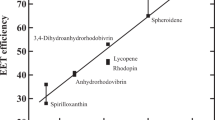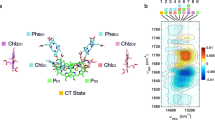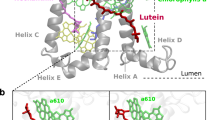Abstract
Carotenoids serve as light-harvesting pigments and as photoprotective agents in photosynthetic organisms1–9. Their role as antenna pigments involves absorption of photons in the blue-green spectral region followed by highly efficient singlet–singlet energy transfer to a neighbouring chlorophyll. The dependence of both the rate and mechanism of energy transfer on carotenoid–chlorophyll distance and orientation is Unknown. Here, we have directly measured both the rate and efficiency of singlet energy transfer from a carotenoid covalently linked to pyropheophorbide a (PPheo a) in two model compounds, using picosecond transient absorption spectroscopy. In one model the π systems of the carotenoid and PPsheo a possess a maximum edge-to-edge distance of 5 Å, while in the other model this distance is only 2Å. Energy transfer occurs from the carotenoid to PPheo a at the 2-Å distance with a rate constant of 7 ± 2 × 1010 s−1 and 53±5% efficiency, while energy transfer at the 5-Å distance occurs at a rate constant of <3 ×109 s−1 and with <5% efficiency. These results provide evidence that short distances and strong electronic interactions between carotenoids and chlorophylls are necessary to achieve the high energy transfer efficiencies observed in vivo.
This is a preview of subscription content, access via your institution
Access options
Subscribe to this journal
Receive 51 print issues and online access
$199.00 per year
only $3.90 per issue
Buy this article
- Purchase on Springer Link
- Instant access to full article PDF
Prices may be subject to local taxes which are calculated during checkout
Similar content being viewed by others
References
Griffiths, M., Sistrom, W. R., Cohen-Bazire, G. & Stanier, R. Y. Nature 176, 1211–1214 (1955).
Cohen-Bazire, G. & Stanier, R. Y. Nature 181, 250–252 (1958).
Wolff, Ch. & Witt, H. T. Z. Naturf. 24b, 1031–1037 (1969).
Monger, T. G., Cogdell, R. J. & Parson, W. W. Biochim. biophys. Acta 449, 136–153 (1976).
Goodwin, T. W. in Chemistry and Biochemistry of Plant Pigments Vol. 1 (ed. Goodwin, T. W.) 228 (Academic, London, 1976).
Mathis, P., Butler, W. L. & Satoh, K. Photochem. Photobiol. 30, 603–614 (1979).
Cogdell, R. J., Hipkins, M. F., MacDonald, W. & Truscott, T. G. Biochim. biophys. Acta 634, 191–202 (1981).
van Grondelle, R., Kramer, H. J. M. & Rijgersberg, C. P. Biochim. biophys. Acta 682, 208–215 (1982).
Siefermann-Harms, D. Biochim. biophys. Acta 811, 325–355 (1985).
Wasielewski, M. R. & Kispert, L. D. Chem. phys. Lett. (in the press).
Razi Naqvi, K. Photochem. Photobiol. 31, 523–524 (1980).
Dirks, G., Moore, A. L., Moore, T. A. & Gust, D. Photochem. Photobiol. 32, 277–280 (1980).
Moore, A. L., Dirks, G., Gust, D. & Moore, T. A. Photochem. Photobiol. 32, 691–696 (1980).
Bensasson, R. V. et al. Nature 290, 329–332 (1981).
Grinvald, A. Analyt. Biochem. 75, 260–280 (1976).
Author information
Authors and Affiliations
Rights and permissions
About this article
Cite this article
Wasielewski, M., Liddell, P., Barrett, D. et al. Ultrafast carotenoid to pheophorbide energy transfer in a biomimetic model for antenna function in photosynthesis. Nature 322, 570–572 (1986). https://doi.org/10.1038/322570a0
Received:
Accepted:
Issue Date:
DOI: https://doi.org/10.1038/322570a0
Comments
By submitting a comment you agree to abide by our Terms and Community Guidelines. If you find something abusive or that does not comply with our terms or guidelines please flag it as inappropriate.



